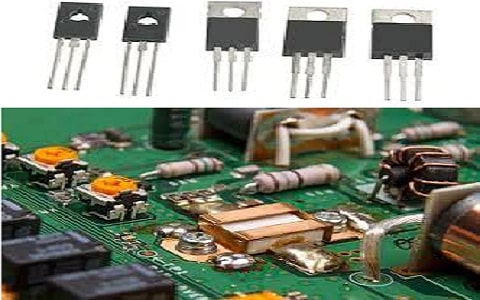Replacing a transistor in an electronic circuit may become necessary due to various reasons such as component failure, the need for an upgrade, or unavailability of the original part. However, this seemingly straightforward task involves careful consideration of several factors to ensure that the replacement transistor seamlessly integrates into the circuit without compromising its performance or reliability. This article delves into the key factors that engineers and hobbyists should consider when replacing transistors in electronic circuits, offering a comprehensive guide to navigating this crucial aspect of electronic design.
Replacing Transistors in Electronic Circuits
For replacing transistors in electronic circuits, there are different factors that need to be considered which are discussed below.

Replacing Transistors in Electronic Circuits
Understanding Transistor Basics:
Before diving into the replacement process, it is essential to have a solid understanding of the basic types of transistors —Bipolar Junction Transistors (BJTs) and Field-Effect Transistors (FETs). Different types have distinct characteristics and pin configurations. Identifying the original transistor’s type, whether it’s an NPN or PNP BJT, or an N-channel or P-channel FET, is the first step towards a successful replacement.
Pin Compatibility:
One of the fundamental considerations when replacing a transistor is ensuring pin compatibility. Pinout configurations can vary between transistors, even within the same category. Consulting the datasheets of both the original and replacement transistors is crucial to verifying pin assignments. If the pins are not compatible, it might require adjustments to the circuit layout or the use of adapter circuits.
Electrical Parameters:
Understanding the electrical parameters of the original transistor is paramount. Critical specifications include voltage ratings, current ratings, power dissipation, and gain characteristics. The replacement transistor should match or exceed these specifications to ensure proper functioning within the circuit’s intended operating conditions. Carefully analyze the datasheets of both transistors to compare these crucial parameters.
Gain and Frequency Response:
In applications involving amplification, such as audio or RF circuits, the gain characteristics of the transistor play a vital role. The replacement transistor should have similar gain characteristics to maintain the desired amplification levels. Additionally, if the circuit operates at high frequencies, it is crucial to consider the frequency response of the replacement transistor to avoid signal distortion.
Voltage Ratings:
Transistor voltage ratings, such as collector-emitter voltage (Vce) for BJTs or drain-source voltage (Vds) for FETs, must be matched or exceeded by the replacement component. Failure to do so may result in breakdown or damage, potentially causing a cascade of failures within the circuit.
Current Ratings:
Matching or surpassing the original transistor’s current ratings is essential to ensure that the replacement device can handle the required currents without overheating or failing. This is particularly important in power-related applications where current flow is a critical parameter.
Power Dissipation:
Power dissipation is a crucial factor, especially in applications where the transistor is subjected to high power levels. The replacement transistor should have a power dissipation rating that is equal to or greater than the original, preventing overheating and ensuring long-term reliability.
Package Type and Mounting:
Consideration should be given to the package type and mounting style of the replacement transistor. Different packages, such as TO-92, TO-220, or surface-mount packages, have varying thermal properties and physical dimensions. The replacement should fit the available space and be compatible with the circuit’s thermal requirements.
Temperature Range:
The operating temperature range is a critical factor, especially in environments with extreme temperatures. Ensure that the replacement transistor can operate within the specified temperature range of the original component to prevent performance degradation or failure under harsh conditions.
Switching Speed and Response Time:
For applications involving switching transistors, such as in digital circuits, it is crucial to consider the switching speed and response time. The replacement transistor should have similar or better characteristics to maintain the circuit’s timing and functionality.
Noise Characteristics:
In circuits where low noise is essential, such as in audio amplifiers or sensitive sensor applications, the noise characteristics of the replacement transistor become significant. Choose a replacement with comparable or lower noise levels to maintain the signal integrity of the circuit.
Environmental Considerations:
Consider the environment in which the circuit operates. Factors such as humidity, vibration, and exposure to chemicals can impact the performance and reliability of transistors. Choose a replacement component with suitable environmental ratings to ensure long-term stability.
Obsolescence and Availability:
In some cases, the original transistor may become obsolete, making it challenging to find an exact replacement. It is essential to explore alternatives that are readily available and meet the necessary specifications. Cross-reference guides, online databases, and discussions within the electronics community can be valuable resources in such situations.
Testing and Validation:
Once a suitable replacement transistor is identified, it is crucial to test and validate its performance in the specific circuit. This may involve bench testing, simulation, or prototype validation to ensure that the replacement transistor functions as expected and does not introduce unforeseen issues.
Replacing transistors in electronic circuits demands a meticulous approach, considering various factors to guarantee seamless integration without compromising performance or reliability. Engineers and hobbyists should leverage datasheets, cross-reference guides, and their understanding of circuit requirements to make informed decisions. By following the comprehensive guide outlined in this article, individuals can navigate the complexities of transistor replacement with confidence, ensuring the continued functionality and longevity of electronic systems.